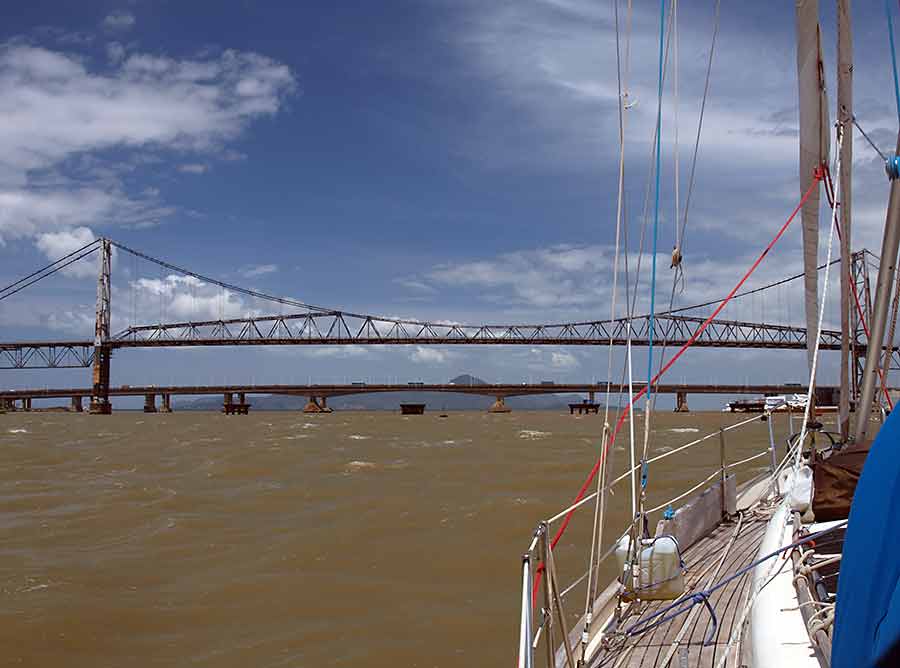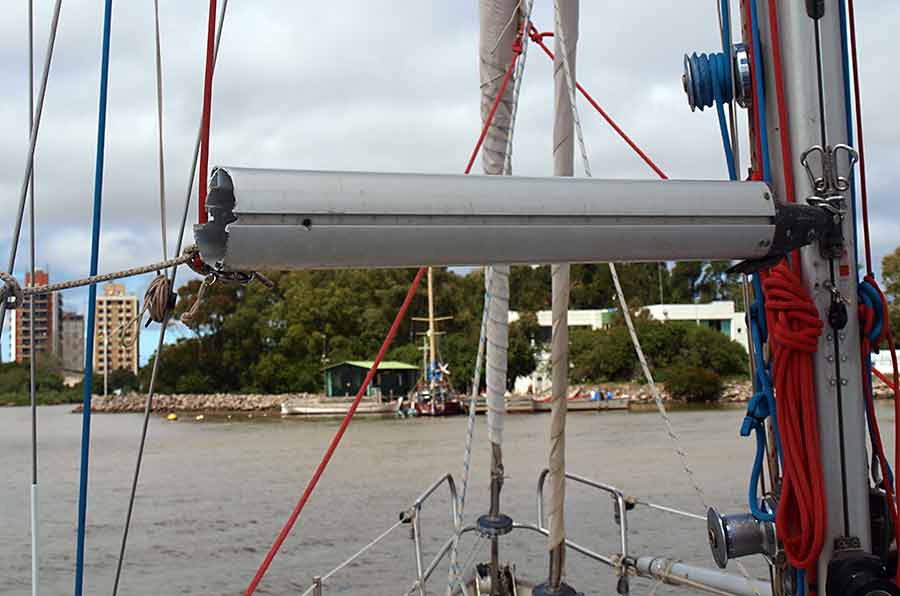boom!

Mystic of Holyhead (successor to Lynn Rival)
Rachel and Paul Chandler
Tue 15 Oct 2013 23:34
32:01.5S 052:06.4W Ex-boom! Read on for details. During our stay on Ilha da Santa Catarina we'd been watching the 10-day forecast which was promising a period of northeasterly winds starting on Thursday. As our departure time got closer the window got smaller so we set off knowing that we might not get all the way to Uruguay - over 500 miles - in one go.  Moorings at SA de L, where Marco (his yacht Nautile closest) made us most welcome Leaving Santo Antonio de Lisboa we took the shallow inshore route, under the bridges at Florianopolis and picking our way between the shallows in the southern bay. To go outside the island would have meant a longer passage including a beat to windward in force 4-5. We calculated that we would have about 1 metre clearance under the lower bridge - enough, but just a little worrying - and at least a foot of water under the keel - provided we navigated carefully through the twenty miles to the open ocean. We had a good wind so, with 2 reefs in the main and 1 in the genoa, we were making at least 6 knots as we swept under the bridge - holding our breath and ducking our heads! - then negotiating our way around the shallows until we were out to sea. The rest of the day was plain down-wind sailing, a little rolly at times but fast, covering over 160 miles in 24 hours.  It looks a big target, but tidal eddies in the shallow (mostly less than 3m!) waters pushed us around a lot Friday was uneventful. The wind dropped a bit yet we still made reasonable progress. The sky was overcast and we saw only a little shipping coming and going from the ports along our route. We hoped to see some of the right whales that frequent these waters at this time of year but our only company was seabirds, especially at dawn when they fly back and forth scanning for fish. Increasingly we are seeing yellow-nosed albatrosses. It's not an especially big bird but is nevertheless majestic. The seabirds are often interested in our fishing line and we are sometimes afraid of catching one!  It looks fairly big to me! (perhaps only about 2m wingspan) By Saturday the wind had dropped quite a bit so we had to shake out the reefs and even use the engine at times. The forecast weather ahead was beginning to look iffy and we wanted to make sure we got to Rio Grande before southerlies set in again. It rained through the night and in the early hours we were running in moderate winds. Rachel, on watch, was sheltering under the sprayhood to keep dry. Suddenly the main was flapping a lot. Looking out in the dark, wet night it looked as if the boom was bent. We'd not heard anything but soon realised that the boom had broken, just in front of the kicker fitting. Paul was woken out of his off-watch slumber and we managed to secure the boom, now in two pieces, and get the mainsail down quickly. Miraculously the sail wasn't damaged, only the mainmate (permanent sail cover) suffered a few lacerations. But why had the boom broken? We were only sailing in moderate winds at the time so it's a bit of a mystery. Were the famous bullet holes to blame? No. They are still intact. For those who wish to form a theory: the break is fairly clean with no buckling of the section and is located just for'ard of the kicker; it started at the underside where there has been corrosion at two (of ten) rivets securing the kicker attachment; for about the lower third of the depth of the section the break is very slightly darkened from exposure for a short while, and the rest of it is bright and shiny. Obviously a hogging failure purely in the vertical plane, but not where Paul would expect the greatest tensile stress to be.  The latest fashion in booms - no clash with shrouds and no need to mind heads in the cockpit! By then we were getting close to the entrance to the channel that leads to the port of Rio Grande and were motoring past many ships at anchor. It was no longer raining much but visibility was poor and at dawn we could only see about a mile. A black object appeared in the sea close by. Was it a whale? No, just a big seal but still the first one we've seen in these waters. Soon we identified the outer channel markers and started the 11 mile slog to our destination. We were supposed to have the tide with us but when northeasterlies have been blowing, there's a strong current coming out from the big lagoon, Lago dos Patos, northeast of Rio Grande. At times we had over 3 knots of current against us but motor sailing with our genoa we were able to make 2-3 knots upstream, dodging out of the current on the starboard side of the channel as much as we dared. Once we reached the long breakwaters that stretch southeast of the port it was still foggy but we could hear strange coughing sounds. Looking carefully at the starboard breakwater we realised that it was covered in seals. Some were in the water, fishing. As we made our way up the channel we also saw porpoises fishing, heedless of the big ships motoring up the channel. Working our way up the channel past all the docks on a foggy morning is a rather depressing experience. And at first sight Rio Grande is an unprepossessing town, but on the other side of the channel the wildlife flourishes in wetland areas teeming with birds. Tired from our overnight drama we dropped anchor just beyond the town, and took it easy for the rest of the day. It didn't take us long to decide what to do about the boom. We've already checked out of Brazil so it makes sense to sail on to Uruguay as soon as the weather permits. The genoa or gennaker and/or engine will suffice, provided we are patient when assessing the weather forecasts. In the meantime we've moved to a small jetty at the Oceanographic Museum, at the kind invitation of the director. The museum grounds are a wildlife haven, with all sorts of interesting collections including cute little turtles, big goldfish and masses of birds tweeting in the trees. There is an wildlife rescue and recovery area, staffed by people wearing 'Petrobras' t-shirts - the massive state oil company presumably a funder. Paul is suffering from a bad back - from manhandling the boom in the middle of the night? - so we've yet to visit the museum.  How do they stop the big heron which lives on the jetty from eating the goldfish? |